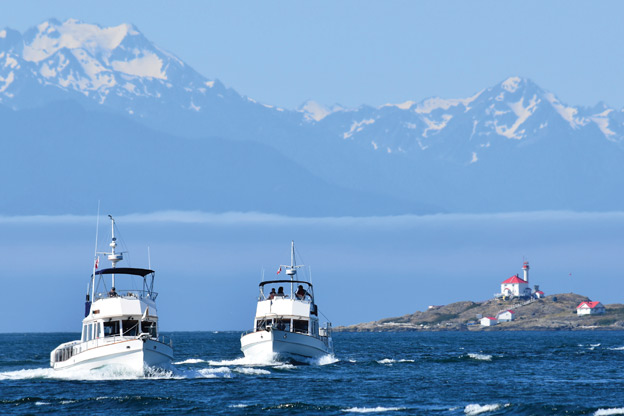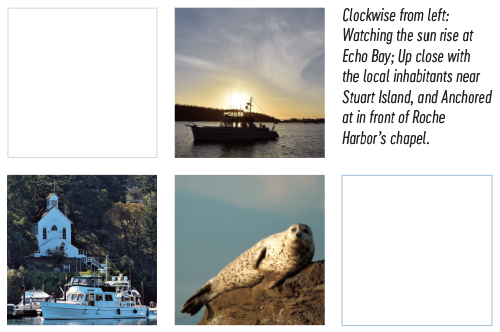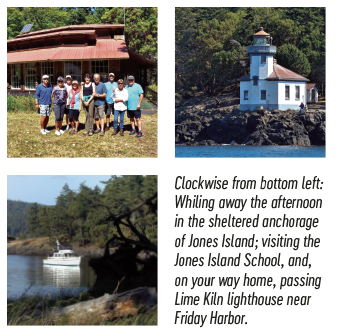Ranked as one of the top 10 island destinations in the U.S., according to Travel + Leisure magazine and others, the San Juan Islands are a boater’s playground. The islands’ rich histories, natural beauty, rare wildlife, and secluded anchorages make this emerald green paradise a must-see for boaters all over the world.
// By Amy Pemberton
 Regardless of your interests, the San Juans have something for you. Tour an eerie mausoleum at Roche Harbor, spot exotic goats along the savannah-like coast of Spieden Island, take a spa day at Rosario Resort, go birdwatching at a secluded sand spit, or spot orcas off beautiful cliffside vistas. The opportunities (and adventures) are endless!
Regardless of your interests, the San Juans have something for you. Tour an eerie mausoleum at Roche Harbor, spot exotic goats along the savannah-like coast of Spieden Island, take a spa day at Rosario Resort, go birdwatching at a secluded sand spit, or spot orcas off beautiful cliffside vistas. The opportunities (and adventures) are endless!
While most people know about the San Juan Island staples that can be reached by ferry, like Mt. Constitution and Friday Harbor, here are some of the best boating spots and best-kept-secrets in the San Juan Islands — many of which can only be reached by personal boat. All of these best-kept secrets represent the combined knowledge of the NW Explorations team, a yacht chartering company with decades of Pacific Northwest boating experience.
SUCIA ISLAND
One of the northernmost islands in the San Juans, Sucia is an absolute gem and a must-see for Pacific Northwest boaters. Almost the entire horseshoe-shaped island is taken up by Washington State Park land—offering up 10 miles of beautiful hiking trails, ancient evergreens, and gorgeous vistas. The most popular place to anchor is at Echo Bay located on the east side of the island. For a more remote anchorage, try Shallow Bay on the west side of the island. The bay’s beautiful sunsets are an added bonus!
Although once a hot spot for smugglers, Sucia is virtually uninhabited today, giving you the chance to enjoy her many coves and inlets in peace and quiet (although, you might hear the occasional sea lion). Sucia’s quiet coves also offer shelter from southern winds, making it the perfect place to seek refuge in a storm.
MATIA ISLAND
About a mile-and-a-half southeast of Sucia is Matia Island, another incredibly remote and beautiful oasis. Matia spans 145 acres and is part of the San Juan Islands National Wildlife Refuge. Matia only has two mooring buoys, so if you’re lucky enough to get a spot, you can usually explore the island in seclusion. There’s also a little-known anchorage on the west side of Matia Island in an unnamed bay just behind Eagle Point.
Camping spots are available on the island, as is a helpful kiosk that details the island’s hiking trails. While exploring, you might even find traces of the “Hermit of Matia”—the infamous squatter who lived on the island in seclusion for more than 30 years.
PATOS ISLAND
The northernmost island in the San Juans, Patos sits right above Sucia and offers more than 200 acres of Washington State Park land. The most iconic sight on Patos is the Patos Island Light Station. Built in 1893, the station once served as a pivotal beacon for ships transiting Boundary Pass and the Strait of Georgia.
Moorage is available in Active Cove on the west side of the island and there’s another small, one-boat cove on the east end of the island at Toe Point. Much like Matia, this island only offers two mooring buoys, so get there early if you want a spot! If you’d like to learn what it was like living on Patos, check out Helen Glidden’s novel, The Light on the Island, based on Gidden’s experience living there as a child with her 12 siblings.
GARRISON BAY
For a more secluded San Juan Island experience, check out Garrison Bay, located on the west side of San Juan Island just south of Roche Harbor. Garrison Bay is one of the few San Juan Island bays that offers full protection from the elements. It’s also home to a historic English Camp that was used in the mid-1800s during the Pig War. Today, the camp showcases a formal garden, original barracks, blockhouse, commissary, and surgeon’s quarters—all maintained by the National Park Service. Rangers can provide camp tours during the spring and summer, or you can explore the camp on your own by downloading a self-guided tour map from the National Park Service website. A dinghy dock provides access to the lovely park grounds and surrounding hiking trails, including one to the top of Young Hill for great views.
ROCHE HARBOR
 Considered one of the best marinas on the West Coast, Roche Harbor is a quaint harbor that boasts plenty of art, history, and fine dining. Tour the historic Hotel de Haro where Teddy Roosevelt enjoyed his favorite baths, or visit the Lady of Good Voyage Church built in the 1880s. The Reserve Sculpture Garden is also a sight to behold. The 19-acre garden showcases a rotating exhibit of 100 sculptures made from bronze, stone, wood, metal, glass, and clay. You can also tour the McMillin Mausoleum, where the harbor’s original founder and family are buried. The mausoleum “Afterglow Vista” is an impressive (and slightly eerie) pillared structure that houses a massive limestone table, chairs, and tomb.
Considered one of the best marinas on the West Coast, Roche Harbor is a quaint harbor that boasts plenty of art, history, and fine dining. Tour the historic Hotel de Haro where Teddy Roosevelt enjoyed his favorite baths, or visit the Lady of Good Voyage Church built in the 1880s. The Reserve Sculpture Garden is also a sight to behold. The 19-acre garden showcases a rotating exhibit of 100 sculptures made from bronze, stone, wood, metal, glass, and clay. You can also tour the McMillin Mausoleum, where the harbor’s original founder and family are buried. The mausoleum “Afterglow Vista” is an impressive (and slightly eerie) pillared structure that houses a massive limestone table, chairs, and tomb.
Also — don’t miss the Color Ceremony, held every evening from May through October, where the resort retires the flags of Roche Harbor, Washington State, Great Britain, Canada, and the U.S., then caps off the evening with a canon blast across the harbor.
STUART ISLAND
Just north of Roche Harbor is the incredibly secluded Stuart Island. By choice, the island has no running water, electricity, or phones—its inhabitants must supply everything on their own. The island is also home to the historic Stuart Island School, a one-room schoolhouse that had two students in 2008 before closing its doors in 2013. Be sure to take a self-guided tour of the school and its museum.
You’ll also want to visit Turn Point Lighthouse. Built in 1893, the lighthouse offers the perfect spot for enjoying a picnic and spotting orcas. If you’d like a souvenir for your trip, stop by the Treasure Chest—a small shop that runs by the honor system. Take what you want and then mail a check when you get home!
LOPEZ ISLAND
The third largest island in the San Juans, Lopez Island is an artsy, cyclist-loving island that has some hidden gems not typically traveled by tourists. The first is Fisherman Bay—a landlocked bay located near Lopez Village—the island’s shopping hub. The entrance to the bay can be tricky to navigate and can only be entered at high tide—because of this, the bay is rarely visited, which means more seclusion for you. After anchoring, it’s a short walk to the village and it’s well worth the stroll. Unlike other San Juan Island villages, Lopez Village has yet to become “touristy.” It’s quiet, relaxing, and the locals still wave and say hello—it’s like taking a step back in time.
 While in the village, enjoy some local fare from Lopez Island Creamery and Lopez Island Vineyards, tour the island’s Historical Society Museum, or, if it’s a Saturday, swing by the farmer’s market from 1000 hours to 1400 hours during the summer.
While in the village, enjoy some local fare from Lopez Island Creamery and Lopez Island Vineyards, tour the island’s Historical Society Museum, or, if it’s a Saturday, swing by the farmer’s market from 1000 hours to 1400 hours during the summer.
Another must-see spot on Lopez is Spencer Spit, a secluded triangular-shaped sand spit on the northeastern shore of the island. The spit offers 138 acres of state land, along with camping sites and some of the best clamming and crabbing on the island. Sunbathe on the spit’s sand and pebble beach, or do some birdwatching at the nearby lagoon.
Watmough Bay, located on the southeast corner of Lopez Island, is another must-see. This well-protected bay offers beautiful rocky cliffs and a relaxing sandy beach. If you’re looking for views, take the trail branching off from the beach, which leads to the top of Chadwick Hill Bluff offering sweeping views of the Strait of Juan de Fuca and Whidbey Island.